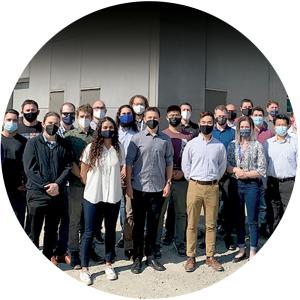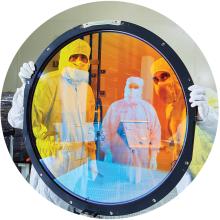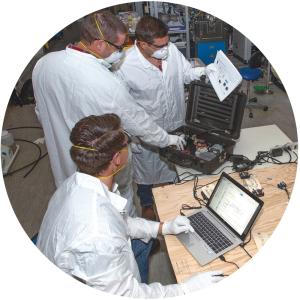Sharing science and technology (S&T) expertise and capabilities to meet our nation’s most important needs
LLNL engages in wide-ranging partnerships with sister laboratories and research institutions, academia, and industry. Many collaborations integrate disparate, special expertise and capabilities that combine to meet challenging mission objectives. Others serve to transition S&T breakthroughs into new applications and products.
The Polymer Production Enclave
In partnership with the Kansas City National Security Campus (KCNSC), LLNL established the Polymer Production Enclave—an innovative approach to accelerating the timeline from early technology development to first production units. Enclaves are vehicles for better integrating activities, modernizing, and increasing the agility and cost effectiveness of the NNSA enterprise. This first enclave is focusing on polymer parts for the W80-4 Life-Extension and the W87-1 Modification programs. LLNL brings to the collaboration more than a decade of experience in additive manufacturing applied to creating complex components and parts. KCNSC brings expertise needed to adapt the technologies to scale and meet demanding production schedules. An enclave with the Pantex Plant on high-explosives production is also being established to support modernization efforts.
At Livermore, the focal point of the Polymer Production Enclave’s activities is the newly opened Applied Materials and Engineering campus, which collocated a synergistic set of capabilities into new and repurposed buildings to gain efficiencies. In May 2020, construction began on Building 225, home of the enclave, and building occupancy took place in April 2021. In summer, LLNL and KCNSC personnel began work in support of the stockpile modernization programs. All programmatic equipment has been installed and is now fully operational.
Large-Scale Optics for the Rubin Observatory
In September 2021, Laboratory researchers completed their work on the Legacy Survey of Space and Time Camera (LSSTCam) for the Vera C. Rubin Observatory in Chile. LSSTCam will start surveying the southern sky in 2024, taking digital images using optical assemblies designed by Livermore researchers and built by the project’s industrial partners. Its camera will photograph the entire visible southern sky frame-by-frame every few nights, creating a time-lapse “movie” of the sky. The collected data will help researchers better understand dark matter and dark energy, detect galaxies and study their formation, track potentially hazardous objects, and observe exploding stars.
Livermore’s finishing task in the LSSTCam project, managed by SLAC National Accelerator Laboratory, was to place six 30-inch-diameter optical filters into LLNL-designed mechanical mounts. This delicate operation benefited from the National Ignition Facility’s state-of-the-art assembly building and skilled technicians who are experienced in handling large optics. With its expertise in large-scale precision optics, the Laboratory has been a key partner in developing Rubin Observatory technology since the project’s inception in the early 2000s. LLNL has made major contributions to the overall telescope design, the camera optics, and project management. A key feature of the telescope assembly is the largest of three Livermore-designed camera lenses, which, at 5.15 feet in diameter, is the is the world’s largest high-performance optical lens.
Universal Vaccine Development
The Laboratory brings more than a decade of experience exploring the use of nanolipoprotein particles (NLPs) as versatile platforms that can connect to other molecules and deliver vaccines and drugs inside the human body. LLNL is engaged in collaborations utilizing NLP platforms to defend against biothreats, develop customized vaccines, and deliver cancer therapeutics. For example, LLNL scientists and research partners have developed a candidate vaccine for tularemia, a pathogen considered to be a biosecurity threat.
In October 2021, LLNL joined the international Human Vaccines Project. The Laboratory will contribute its expertise and supercomputing resources to aid in developing a universal coronavirus vaccine and improve understanding of immune response. LLNL’s prowess continues to grow from research performed as part of DOE’s National Virtual Biotechnology Laboratory, which is helping to fight COVID-19, and as a founding member of the Accelerating Therapeutics for Opportunities in Medicine (ATOM) consortium to speed up drug development.
Successful Industrial Partnerships
LLNL is benefiting the U.S. economy with innovative technology and methodologies. In FY 2021, Livermore obtained 95 new patents, asserted 126 new copyrights, and executed 89 new licenses. Licensing income for the year totaled approximately $5.9 million. Among many honors, Livermore earned three R&D 100 awards from R&D World magazine (see box below). LLNL also won three national Federal Laboratory Consortium awards for Excellence in Technology Transfer for the following technologies: DropletTM Digital Polymerase Chain Reaction to diagnose the SARS-CoV-2 virus, the SuppleVentTM mechanical ventilator to assist those suffering from Acute Respiratory Distress Syndrome, and the Radiation Field Training Simulator for realistic first-responder training. In addition, the Laboratory secured five major grants through the DOE’s Technology Commercialization Fund and three projects with industry through the LLNL-managed DOE High Performance for Energy Innovation Program.
Three Top-100 Industrial Inventions
In FY 2021, the Laboratory and partners earned three R&D 100 awards from R&D World. An LLNL-patented, light-activated switch is being commercialized that could significantly reduce carbon emissions from the electrical grid (see Energy and Environment).
LLNL and collaborators developed Flux, a next-generation toolset to efficiently schedule workloads and reduce bottlenecks at data centers. The third winner is an instrument to help emergency responders quickly identify and assess nuclear threats.







